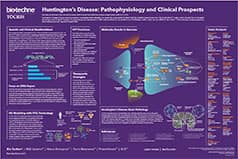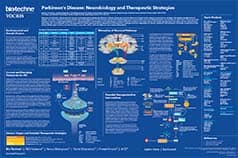NMDA Receptors
NMDA receptors are members of the ionotropic class of glutamate receptors, which also includes Kainate and AMPA receptors. NMDA receptors are tetramers that consist of GluN1 subunits combined with GluN2 (A-D) or GluN3 (A-B) subunits. These complex and unique receptors mediate excitatory synaptic transmission, in conjunction with AMPA receptors.
NMDA Receptor Agonists |
|
|---|---|
| Cat. No. | 产品名称/活性 |
| 0281 | (R)-(+)-HA-966 |
| NMDA partial agonist/antagonist; acts at glycine site | |
| 0285 | Ibotenic acid |
| NMDA agonist; also non selective mGlu agonist | |
| 0114 | NMDA |
| Selective NMDA agonist | |
| 0312 | (RS)-(Tetrazol-5-yl)glycine |
| Highly potent NMDA agonist | |
NMDA Receptor Antagonists |
|
| Cat. No. | 产品名称/活性 |
| 3693 | DL-AP5 Sodium salt |
| Potent and selective NMDA antagonist; sodium salt of DL-AP5 | |
| 0106 | D-AP5 |
| Potent and selective NMDA receptor antagonist; more active form of DL-AP5 | |
| 0105 | DL-AP5 |
| Potent and selective NMDA antagonist | |
| 0107 | L-AP5 |
| Potent and selective NMDA antagonist; less active form of DL-AP5 | |
| 4492 | Cerestat |
| Potent and noncompetitive NMDA antagonist | |
| 1469 | CGP 37849 |
| Potent and selective NMDA antagonist | |
| 1493 | CGP 78608 hydrochloride |
| Potent and selective NMDA antagonist; acts at glycine site | |
| 1241 | CGS 19755 |
| Potent competitive NMDA antagonist | |
| 3697 | 7-Chlorokynurenic acid sodium salt |
| Sodium salt of 7-Chlorokynurenic acid | |
| 0237 | 7-Chlorokynurenic acid |
| NMDA antagonist; acts at glycine site | |
| 0190 | CNQX |
| NMDA antagonist; acts at glycine site; also AMPA/kainate antagonist | |
| 2456 | Co 101244 hydrochloride |
| GluN2B-selective NMDA antagonist | |
| 0247 | (R)-CPP |
| Potent NMDA antagonist; more active enantiomer of (RS)-CPP | |
| 0173 | (RS)-CPP |
| Potent NMDA antagonist | |
| 1265 | D-CPP-ene |
| Potent competitive NMDA antagonist | |
| 0286 | 5,7-Dichlorokynurenic acid |
| Potent NMDA antagonist; acts at glycine site | |
| 3698 | 5,7-Dichlorokynurenic acid sodium salt |
| Potent NMDA antagonist, acts at glycine site; sodium salt of 5,7-Dichlorokynurenic acid | |
| 4491 | DQP 1105 |
| GluN2C/GluN2D-selective NMDA antagonist | |
| 2867 | Flupirtine maleate |
| Indirect NMDA antagonist; also GABAA modulator and Kv7 channel activator | |
| 2348 | Gavestinel |
| Potent and selective NMDA antagonist; acts at the glycine site | |
| 0545 | Ifenprodil hemitartrate |
| Non-competitive NMDA antagonist; also σ ligand | |
| 3131 | Ketamine hydrochloride |
| Non-competitive NMDA antagonist | |
| 6751 | (R)-(-)-Ketamine hydrochloride |
| NMDA antagonist; antidepressant; may not display psychotomimetic or addictive side effects of (S)-ketamine | |
| 4379 | (S)-(+)-Ketamine hydrochloride |
| NMDA antagonist; enantiomer of ketamine hydrochloride | |
| 0742 | L-689,560 |
| Highly potent NMDA antagonist | |
| 0907 | L-701,324 |
| NMDA antagonist; acts at glycine site | |
| 0773 | Memantine hydrochloride |
| NMDA antagonist; acts at ion channel site | |
| 0924 | (+)-MK 801 maleate |
| Non-competitive NMDA antagonist; acts at ion channel site | |
| 0955 | (-)-MK 801 maleate |
| NMDA antagonist; less active enantiomer of (+)-MK 801 | |
| 1970 | Norketamine hydrochloride |
| Potent non-competitive NMDA antagonist; antinociceptive | |
| 5018 | PEAQX tetrasodium salt |
| Potent and GluN2A-selective NMDA antagonist | |
| 2557 | Phencyclidine hydrochloride |
| Non-competitive NMDA antagonist | |
| 2530 | PPDA |
| GluN2C/GluN2D-selective NMDA antagonist | |
| 4801 | QNZ 46 |
| Non-competitive and GluN2C/GluN2D-selective NMDA antagonist | |
| 1594 | Ro 25-6981 maleate |
| GluN2B-selective NMDA antagonist | |
| 3254 | Ro 61-8048 |
| NMDA antagonist; increases kynurenic acid levels | |
| 4154 | TCN 201 |
| GluN1/GluN2A-selective NMDA antagonist | |
NMDA Receptor Modulators |
|
| Cat. No. | 产品名称/活性 |
| 4105 | CIQ |
| Potentiator of NMDA receptors containing GluN2C/GluN2D | |
| 0219 | Glycine |
| Endogenous potentiator of NMDA receptors | |
| 6369 | GNE 9278 |
| Positive allosteric modulator of NMDA receptors; acts in transmembrane domain | |
| 2851 | Nefiracetam |
| Cognitive enhancer; potentiates NMDA currents | |
| 5996 | (R)-Norketamine hydrochloride |
| NMDA modulator; metabolite of Ketamine hydrochloride | |
| 6112 | (S)-Norketamine hydrochloride |
| NMDA modulator; metabolite of Ketamine hydrochloride | |
| 1067 | Oxotremorine M |
| Potentiator of NMDA receptors; also muscarinic M1 agonist | |
| 5376 | Pregnenolone sulfate sodium salt |
| NMDA potentiator; also GABAA inhibitor and TRPM3 activator | |
| 0226 | D-Serine |
| Potentiator of NMDA recepors; acts at glycine site | |
Other |
|
| Cat. No. | 产品名称/活性 |
| 6095 | 2S,6S-Hydroxynorketamine hydrochloride |
| Ketamine metabolite; decreases D-serine (a NMDA co-agonist); antidepressant | |
| 1636 | IEM 1460 |
| Open-channel blocker of NMDA currents; also blocks AMPA currents | |
| 0958 | Spermine tetrahydrochloride |
| Modulator at polyamine site | |
NMDA receptors are expressed alongside AMPA receptors on the postsynaptic membrane of excitatory synapses, where they initiate a two-component excitatory postsynaptic potential (EPSP). The activation of AMPA receptors produces a current that has rapid onset and decay, while activation of NMDA receptors leads to a current with slower onset and decay. The slow decay of NMDA-mediated currents is due to the slow dissociation of glutamate from NMDA receptors, compared with AMPA receptors. Unlike other ionotropic glutamate receptors, NMDA receptors are highly permeable to Ca2+.
NMDA Receptor Structure
NMDA receptors are heteromeric tetramers, with every endogenously expressed NMDA receptor containing at least one GluN1 subunit, in combination with one or more GluN2 or GluN3 subunits. There is high variability in the exact subunit combination of endogenous NMDA receptors, as there have been 9 splice variants of GluN1 identified, as well as four genes for GluN2 (A to D) and two genes for GluN3 (A and B). The exact subunit conformation of a NMDA receptor determines the ability of the receptor to bind different ligands and the Ca2+ permeability of the receptor.
During postnatal development the subunit combinations expressed in the brain change. In early postnatal development, NMDA receptors are primarily composed of N1 and N2B subunits, resulting in very long-lasting synaptic responses. However, during the first weeks of brain development, the N2B subunit is replaced with N2A or N2C, leading to a shorter synaptic response.
Unique features of NMDA Receptors
NMDA receptors have properties that set them apart from other ligand-gated ion channels:
- divalent cation block
- multiple ligands required for activation
- a third pharmacological binding site within the ion pore
At resting membrane potentials, extracellular Mg2+ and Zn2+ block the ion pore of NMDA receptors, so that even in the presence of glutamate there is very little ion flow. Depolarization of the postsynaptic membrane where NMDA receptors are expressed is required to remove this block. Repetitive stimulation of the postsynaptic neuron is required to relieve the Mg2+/Zn2+ block, suggesting that NMDA receptors can detect simultaneous activity at adjacent receptors on the synaptic membrane. However, this sustained activation of the postsynaptic membrane can lead to glutamate excitotoxicity, due to the large influx of Ca2+ through extrasynaptic NMDA receptors. This has been postulated as a cause of cell death in neurogenerative diseases, such as Alzheimer's disease and Parkinson's disease.
Another unique feature of NMDA receptors is the requirement for two ligands to bind for endogenous activation. Both glutamate and glycine are required to bind at their respective binding sites. These ligands are referred to as co-agonists, and neither can activate the receptor without the other. Both the glutamate and glycine binding sites are targets for drugs. D-serine can also activate NDMA receptors with glutamate by binding to the glycine binding site; it is more potent than glycine. D-serine is released from glial cells in the CNS, suggesting a critical role for glial cells in modulating NMDA synaptic function.
The third unique feature of NMDA receptors is the presence of a third pharmacological binding site, within the ion pore near the Mg2+/Zn2+ blocking point. Drugs that bind at this site, such as MK 801 and Ketamine, physically block ion flow through the ion channel pore, and are described as non-competitive antagonists. At lower concentrations these compounds are psychotomimetic causing cognitive impairments, hallucinations and delusions, while at higher concentrations they are dissociative anesthetics.
External sources of pharmacological information for NMDA Receptors :
Literature for NMDA Receptors
Tocris offers the following scientific literature for NMDA Receptors to showcase our products. We invite you to request* your copy today!
*Please note that Tocris will only send literature to established scientific business / institute addresses.
Huntington's Disease Research Product Guide
This product guide provides a background to Huntington's disease research and lists around 100 products for the study of:
- Somatic Instability
- Proteolysis and Inclusion Bodies
- Transcriptional Dysregulation
- Mitochondrial Dysfunction
- Nuclear-Cytoplasmic Transport Interference
- Excitotoxicity
- Stem Cells
Depression Poster
Major depressive disorder is characterized by depressed mood and a loss of interest and/or pleasure. Updated in 2015 this poster highlights presynaptic and postsynaptic targets for the potential treatment of major depressive disorder, as well as outlining the pharmacology of currently approved antidepressant drugs.
Huntington's Disease Poster
Huntington's disease (HD) is a severe monogenic neurodegenerative disorder, which is characterized by the prevalent loss of GABAergic medium spiny neurons (MSN) in the striatum. This poster summarizes the effects of mutant huntingtin aggregation implicated in the pathology of HD, as well as highlighting the use of iPSCs for HD modeling.
Parkinson's Disease Poster
Parkinson's disease (PD) causes chronic disability and is the second most common neurodegenerative condition. This poster outlines the neurobiology of the disease, as well as highlighting current therapeutic treatments for symptomatic PD, and emerging therapeutic strategies to delay PD onset and progression.
NMDA Receptor Gene Data
| Gene | Species | Gene Symbol | Gene Accession No. | Protein Accession No. |
|---|---|---|---|---|
| GluN1 | Human | GRIN1 | NM_021569 | Q05586 |
| Mouse | Grin1 | NM_008169 | P35438 | |
| Rat | Grin1 | NM_017010 | P35439 | |
| GluN2A | Human | GRIN2A | NM_000833 | Q12879 |
| Mouse | Grin2a | NM_008170 | P35436 | |
| Rat | Grin2a | NM_012573 | Q00959 | |
| GluN2B | Human | GRIN2B | NM_000834 | Q13224 |
| Mouse | Grin2b | NM_008171 | Q01097 | |
| Rat | Grin2b | NM_012574 | Q00960 | |
| GluN2C | Human | GRIN2C | NM_000835 | Q14957 |
| Mouse | Grin2c | NM_010350 | Q01098 | |
| Rat | grin2c | NM_012575 | Q00961 | |
| GluN2D | Human | GRIN2D | NM_000836 | O15399 |
| Mouse | Grin2d | NM_008172 | Q03391 | |
| Rat | Grin2d | NM_022797 | Q62645 | |
| GluN3A | Human | GRIN3A | NM_133445 | Q8TCU5 |
| Mouse | Grin3a | NM_001033351 | NP_001028523 | |
| Rat | Grin3a | AF073379 | Q9R1M7 | |
| GluN3B | Human | GRIN3B | NM_138690 | O60391 |
| Mouse | Grin3b | NM_130455 | Q91ZU9 | |
| Rat | Grin3b | NM_133308 | Q8VHN2 |




